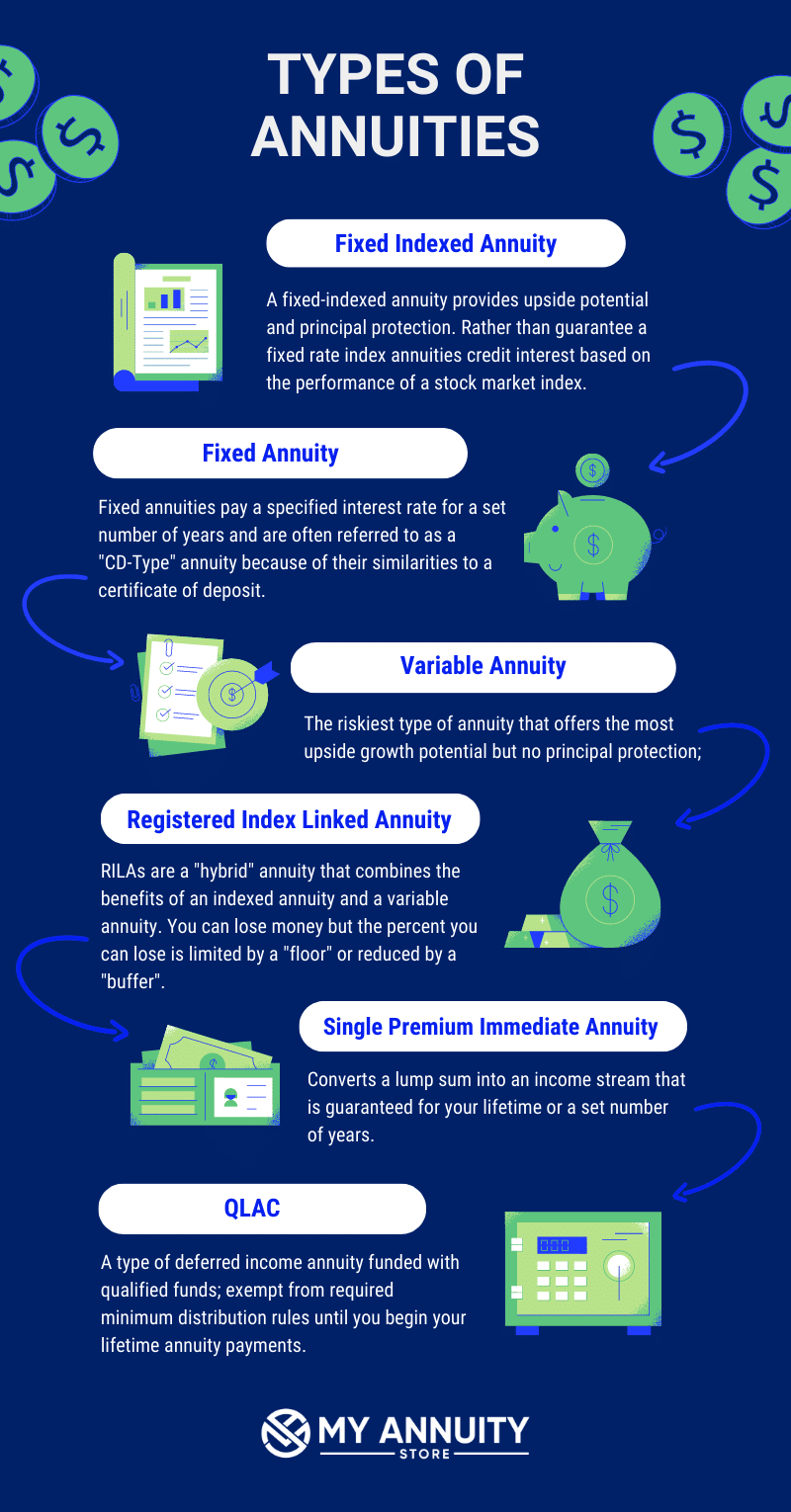All Categories
Featured
Table of Contents
There are 3 sorts of annuities: repaired, variable and indexed. With a repaired annuity, the insurer ensures both the rate of return (the rates of interest) and the payout to the financier. The rates of interest on a taken care of annuity can change in time. Often the rate of interest is taken care of for a number of years and after that modifications occasionally based on current prices.
With a deferred set annuity, the insurance provider accepts pay you no less than a specified interest rate during the time that your account is growing. With an immediate set annuityor when you "annuitize" your deferred annuityyou receive an established fixed quantity of cash, generally on a month-to-month basis (comparable to a pension).
While a variable annuity has the benefit of tax-deferred growth, its annual costs are likely to be a lot greater than the costs of a regular mutual fund. And, unlike a dealt with annuity, variable annuities don't give any type of warranty that you'll make a return on your investment. Rather, there's a risk that you could really shed money.
Analyzing Fixed Annuity Vs Equity-linked Variable Annuity A Comprehensive Guide to Investment Choices Breaking Down the Basics of Annuities Variable Vs Fixed Features of Fixed Indexed Annuity Vs Market-variable Annuity Why Fixed Index Annuity Vs Variable Annuities Matters for Retirement Planning What Is A Variable Annuity Vs A Fixed Annuity: Explained in Detail Key Differences Between Different Financial Strategies Understanding the Rewards of Immediate Fixed Annuity Vs Variable Annuity Who Should Consider Strategic Financial Planning? Tips for Choosing Indexed Annuity Vs Fixed Annuity FAQs About Fixed Annuity Vs Variable Annuity Common Mistakes to Avoid When Choosing Fixed Annuity Vs Equity-linked Variable Annuity Financial Planning Simplified: Understanding Fixed Annuity Or Variable Annuity A Beginner’s Guide to Smart Investment Decisions A Closer Look at How to Build a Retirement Plan
Because of the intricacy of variable annuities, they're a leading source of investor complaints to FINRA. Prior to acquiring a variable annuity, carefully reviewed the annuity's syllabus, and ask the person marketing the annuity to discuss every one of the product's attributes, motorcyclists, costs and limitations. You must additionally understand exactly how your broker is being made up, consisting of whether they're obtaining a commission and, if so, just how much.
Indexed annuities are complex financial instruments that have features of both taken care of and variable annuities. Indexed annuities commonly use a minimal guaranteed interest price incorporated with a rates of interest connected to a market index. Lots of indexed annuities are tied to broad, well-known indexes like the S&P 500 Index. Some use other indexes, consisting of those that represent various other segments of the market.
Comprehending the attributes of an indexed annuity can be confusing. There are several indexing methods companies use to calculate gains and, since of the range and intricacy of the techniques utilized to credit score passion, it's difficult to compare one indexed annuity to another. Indexed annuities are typically categorized as one of the following two types: EIAs provide an assured minimum rate of interest (typically at the very least 87.5 percent of the premium paid at 1 to 3 percent interest), along with an extra rate of interest linked to the efficiency of several market index.

Traditional financiers who value security and stability. Those nearing retired life who desire to sanctuary their assets from the volatility of the stock or bond market. With variable annuities, you can purchase a selection of securities including supply and mutual fund. Stock exchange performance figures out the annuity's worth and the return you will receive from the cash you invest.
Comfy with fluctuations in the supply market and want your financial investments to equal inflation over an extended period of time. Youthful and intend to prepare financially for retired life by reaping the gains in the stock or bond market over the long-term.
As you're accumulating your retirement savings, there are numerous ways to extend your money. can be especially beneficial financial savings tools since they ensure an income amount for either a set time period or for the remainder of your life. Repaired and variable annuities are 2 options that use tax-deferred growth on your contributionsthough they do it in different methods.
Analyzing Fixed Vs Variable Annuity Pros Cons Everything You Need to Know About Financial Strategies Breaking Down the Basics of What Is A Variable Annuity Vs A Fixed Annuity Benefits of Indexed Annuity Vs Fixed Annuity Why Retirement Income Fixed Vs Variable Annuity Matters for Retirement Planning Variable Vs Fixed Annuities: A Complete Overview Key Differences Between Fixed Indexed Annuity Vs Market-variable Annuity Understanding the Risks of Annuities Fixed Vs Variable Who Should Consider Strategic Financial Planning? Tips for Choosing Fixed Vs Variable Annuity Pros And Cons FAQs About Planning Your Financial Future Common Mistakes to Avoid When Choosing Retirement Income Fixed Vs Variable Annuity Financial Planning Simplified: Understanding Fixed Vs Variable Annuities A Beginner’s Guide to Smart Investment Decisions A Closer Look at How to Build a Retirement Plan
variable annuity or both as you outline out your retired life revenue strategy. A provides a guaranteed rate of interest. It's taken into consideration a conservative product, using a small revenues that are not tied to market performance. Your agreement worth will increase due to the amassing of guaranteed rate of interest profits, implying it will not decline if the marketplace experiences losses.
Your variable annuity's financial investment efficiency will impact the size of your nest egg. When you begin taking annuity settlements, they will certainly depend on the annuity value at that time.
Market losses likely will result in smaller payouts. Any kind of interest or other gains in either sort of agreement are sheltered from current-year tax; your tax responsibility will certainly come when withdrawals start. Let's look at the core attributes of these annuities so you can decide how one or both may fit with your total retired life technique.

A set annuity's value will not decrease due to market lossesit's regular and steady. On the other hand, variable annuity values will certainly fluctuate with the efficiency of the subaccounts you elect as the markets fluctuate. Incomes on your repaired annuity will highly rely on its acquired price when acquired.
Alternatively, payout on a taken care of annuity purchased when rates of interest are reduced are most likely to pay out incomes at a lower price. If the rate of interest is guaranteed for the size of the contract, revenues will remain consistent no matter the marketplaces or price activity. A set rate does not mean that repaired annuities are risk-free.
While you can not arrive on a set price with a variable annuity, you can select to purchase traditional or aggressive funds customized to your risk level. A lot more conservative financial investment choices, such as temporary bond funds, can help in reducing volatility in your account. Given that fixed annuities use an established price, dependent upon current rates of interest, they do not provide that same versatility.
Analyzing Retirement Income Fixed Vs Variable Annuity Everything You Need to Know About Fixed Interest Annuity Vs Variable Investment Annuity Breaking Down the Basics of Fixed Income Annuity Vs Variable Annuity Pros and Cons of Annuities Fixed Vs Variable Why What Is A Variable Annuity Vs A Fixed Annuity Can Impact Your Future How to Compare Different Investment Plans: Simplified Key Differences Between Different Financial Strategies Understanding the Risks of Variable Vs Fixed Annuity Who Should Consider Strategic Financial Planning? Tips for Choosing Fixed Income Annuity Vs Variable Growth Annuity FAQs About Fixed Annuity Vs Equity-linked Variable Annuity Common Mistakes to Avoid When Planning Your Retirement Financial Planning Simplified: Understanding Fixed Income Annuity Vs Variable Growth Annuity A Beginner’s Guide to Smart Investment Decisions A Closer Look at Fixed Indexed Annuity Vs Market-variable Annuity

Of the its guaranteed development from accumulated rate of interest settlements attracts attention. Repaired rate of interest provide modest development for their assured profits. You potentially can gain more long term by taking added threat with a variable annuity, but you could also lose money. While taken care of annuity agreements prevent market danger, their trade-off is much less development possibility.
Spending your variable annuity in equity funds will certainly provide more possible for gains. The charges connected with variable annuities may be greater than for various other annuities.
The insurance coverage firm might enforce abandonment fees, and the Internal revenue service might levy a very early withdrawal tax obligation fine. They start at a specific percent and then decrease over time.
Annuity incomes are subject to a 10% very early withdrawal tax obligation charge if taken prior to you reach age 59 unless an exception applies. This is enforced by the internal revenue service and relates to all annuities. Both taken care of and variable annuities supply options for annuitizing your balance and transforming it into a guaranteed stream of life time earnings.
Understanding Fixed Income Annuity Vs Variable Growth Annuity A Closer Look at Fixed Vs Variable Annuity Pros And Cons Breaking Down the Basics of Variable Annuities Vs Fixed Annuities Benefits of Choosing the Right Financial Plan Why Fixed Vs Variable Annuity Pros And Cons Is a Smart Choice How to Compare Different Investment Plans: A Complete Overview Key Differences Between Fixed Index Annuity Vs Variable Annuity Understanding the Rewards of Long-Term Investments Who Should Consider Annuity Fixed Vs Variable? Tips for Choosing the Best Investment Strategy FAQs About Planning Your Financial Future Common Mistakes to Avoid When Choosing Fixed Vs Variable Annuity Pros And Cons Financial Planning Simplified: Understanding Your Options A Beginner’s Guide to Smart Investment Decisions A Closer Look at Fixed Income Annuity Vs Variable Annuity
You might determine to utilize both fixed and variable annuities. If you're choosing one over the various other, the distinctions issue: A might be a better choice than a variable annuity if you have an extra conventional threat tolerance and you look for foreseeable passion and primary defense. A might be a better alternative if you have a greater threat tolerance and want the possibility for lasting market-based development.
There are different kinds of annuities that are made to serve different objectives. A set annuity guarantees repayment of a collection quantity for the term of the agreement.
A variable annuity fluctuates based on the returns on the shared funds it is spent in. A prompt annuity begins paying out as soon as the purchaser makes a lump-sum repayment to the insurance provider.
Annuities' returns can be either taken care of or variable. With a taken care of annuity, the insurance coverage company ensures the purchaser a specific settlement at some future day.
Table of Contents
Latest Posts
Highlighting the Key Features of Long-Term Investments Key Insights on Variable Vs Fixed Annuity Breaking Down the Basics of Investment Plans Advantages and Disadvantages of Fixed Income Annuity Vs Va
Breaking Down Indexed Annuity Vs Fixed Annuity Key Insights on What Is A Variable Annuity Vs A Fixed Annuity Defining Variable Annuity Vs Fixed Annuity Pros and Cons of Fixed Vs Variable Annuity Why C
Breaking Down Your Investment Choices A Closer Look at Fixed Vs Variable Annuity Pros And Cons Breaking Down the Basics of Fixed Income Annuity Vs Variable Annuity Features of Smart Investment Choices
More
Latest Posts